NIKON AF-S DX Nikkor 18-105 VR User Manual [fr]
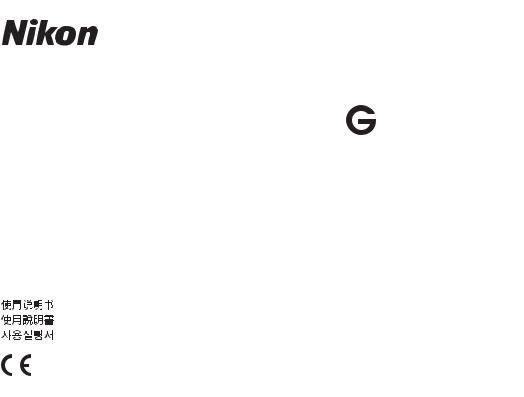
AF-S DX NIKKOR |
|
|
|
18-105mm f/3.5-5.6 |
ED VR |
||
|
|
|
|
P. 2-11 |
|
Jp |
|
User’s Manual |
PP. 12-19 |
|
En |
Benutzerhandbuch |
S. 20-27 |
|
De |
Manuel de l’utilisateur |
P. 28-35 |
|
Fr |
Manual del Usuario |
PP. 36-43 |
|
Es |
Användarhandbok |
S. 44-51 |
|
Sv |
Pykoводство пользoвaтеля |
СТР. 52-59 |
|
Ru |
Gebruikshandleiding |
P. 60-67 |
|
Nl |
Manuale d’uso |
PP. 68-75 |
|
It |
|
P. 76-87 |
|
Ck |
|
P. 88-95 |
|
Ch |
|
P. 96-107 |
|
Kr |
|
|
|
|


Jp |
|
|



2
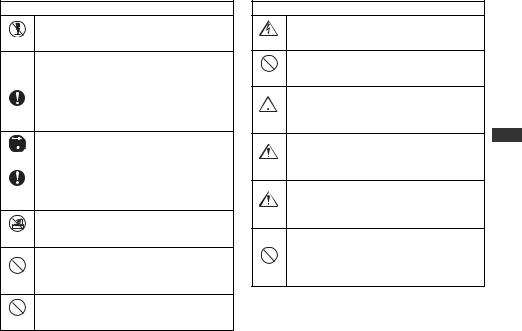


カメラの電池を抜いて、販売店またはニコンサー

依頼を
いこと
使用禁止


Jp
ります。
|
|
|
|
|
|
|
|
|
|
||
|
ことがあります。
3
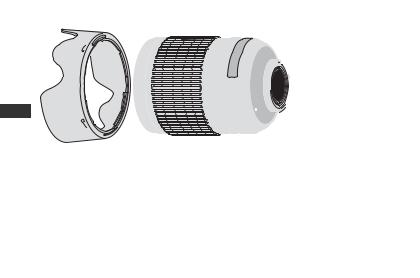
Jp
|
|
|
|
1 |
P. 6 |
|
2 |
P. 6 |
|
3 |
P. 6 |
|
4 |
P. 6 |
|
5 |
P. 6 |
|
6 |
|
|
7 |
|
|
8 |
P. 7 |
|
9 |
P. 5 |
|
0 CPU P. 9 |
|
A |
a A-M P. 7 |
|
b P. 8 |
||
B C D
4
DX DXD300 D90DX 35mm 1.5
|
|
VR 1 OFF3 2 D3 9
9
|
4 C |
|
Jp |
AF
A-M a OFF
AF MF
備え、3D
ED
5

HB-321
4 2 2 1B
2 2 1B
 3
3
Jp
カメラ側から見て時計回りにフードを回転させて取り 外します。
リング5
持つカメラでは、撮影前に 被写界深度を確認できま
6

A
AF-A AF-S AF-CA-M a A
A-M A
AF-S8
グを回転させないでください。オートフォーカス が停止したときには、再度、半押ししてください。
|
|
|
||
A-M a M |
||||
8 |
||||
AF |
||||
M |
|
|||
A-M |
|
|
||
|
AF-A/AF-C |
AF-S |
M |
|
a |
||||
|
|
|
||
|
|
|
|
|
A |
|
|
|
|
|
|
Jp |
||
|
||||
|
|
|
||
|
|
|
||
M |
|
|
||
|
|
|||
|
|
|||
|
||||
|
|
|
||
|
|
|||
|
||||
P. 11 |
|
|
||
7

VR
3
1b ONb
2 Jp
3b OFF
た場合、流した方向の手ブレ補正は機能しません。例 えば、流し撮りで横方向にパンニングすると、縦方向 の手ブレだけが補正され、流し撮りが行えます。
OFF
を再度ON
D300 D40
b OFF
[ON
AF D2 D300AF
F
F 11/3F
8

がレンズのフード1
1
0.6m
|
|
|
|
|
|
D5000/D3000 |
• 18mm 2.5m |
|
|
• 24mm 1.0m |
|
D700/ |
|
|
D300 / |
|
|
D200/D100/ |
|
|
D80 |
|
|
|
|
|
D90/ |
• 18mm 1.5m |
|
D70 |
• 24mm |
|
D50 |
• 18mm 1.0m |
|
• 24mm |
|
|
|
|
|
D60/ |
• 18mm 2.5m |
|
• 24mm 1.0m |
|
|
D40 |
|
|
• 35mm |
|
D100/D70 20mm18mm
CPU 0
リーナーを少量湿らせ、レンズの中心から外周へ渦巻 状に、拭きムラ、拭き残りのないように注意して拭い てください。
NC Jp1
ド1
1
9
|
|
|
|
|
|
67mm LC-67 |
|
F CPU G |
|
|
LF-1 |
|
AF-S DX |
|
|
|
|
||
|
HB-32 |
|
||
|
|
DX |
||
|
CL-1018 |
|
||
|
|
18mm―105mm |
||
|
|
|
1 3.5―5.6 |
|
|
|
11 15 1 ED |
||
|
67mm |
|||
|
|
1 |
||
|
|
|
76°―15°20′ |
|
|
|
18 24 35 50 70 105mm |
||
|
|
|
|
|
Jp |
|
|
||
PK |
||||
|
|
IF |
||
|
K |
|||
|
|
|
||
|
BR-4 |
|
||
|
|
|
||
|
|
|
||
|
|
VCM |
||
|
SX-1 |
|||
|
|
|
||
|
|
|
0.45 m |
|
|
|
|
7 |
|
|
|
|
|
|
|
|
|
18mm f/3.5―22 |
|
|
|
|
105mm f/5.6―38 |
|
|
|
|
|
|
|
|
67 mm P=0.75 mm |
||
|
|
|
76 mm ×89 mm |
|
|
|
|
|
|
|
|
|
420 g |
|
とがあります。
10
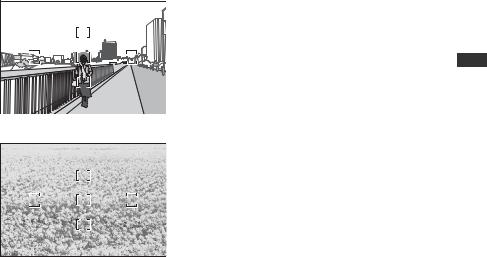
E |
1. |
|
|
|
|
|
|
|
|
|
|
|
|
E |
|
|
|
|
|
|
|
|
|
|
|
|
Jp |
|
2. |
|
|
|
|
||
|
|
F |
|
|
|
|
|
|
|
|
|
F |
|
|
|
1 2 |
|
||
|
|
||
|
|
|
|
|
|
|
|
|
|
|
|
|
|
|
|
|
|
|
|
|
|
|
|
|
|
|
|
|
|
|
|
11
Notes on Safety Operations
 CAUTION
CAUTION
Do not disassemble
|
Touching the internal parts of the camera or lens could |
|
|
result in injury. Repairs should be performed only by |
|
|
qualified technicians. Should the camera or lens break |
|
|
open as the result of a fall or other accident, take the |
|
|
product to a Nikon-authorized service representative for |
|
|
inspection after unplugging the product and/or removing |
|
|
the battery. |
|
|
Turn off immediately in the event of malfunction |
|
|
Should you notice smoke or an unusual smell coming from |
|
En |
||
the camera or lens, remove the battery immediately, taking |
||
|
||
|
care to avoid burns. Continued operation could result in |
|
|
injury. |
|
|
After removing or disconnecting the power source, take |
|
|
the product to a Nikon-authorized service representative |
|
|
for inspection. |
|
|
Do not use the camera or lens in the presence of |
|
|
flammable gas |
|
|
Operating electronic equipment in the presence of |
|
|
flammable gas could result in an explosion or fire. |
|
|
Do not look at the sun through the lens or viewfinder |
|
|
Viewing the sun or other strong light sources through the |
|
|
lens or viewfinder could cause permanent visual |
|
|
impairment. |
Keep out of reach of children
Particular care should be taken to prevent infants from putting the batteries or other small parts into their mouths.
Observe the following precautions when handling the camera and lens
•Keep the camera and lens unit dry. Failure to do so could result in fire or electric shock.
•Do not handle or touch the camera or lens unit with wet hands. Failure to do so could result in electric shock.
•When shooting with back-lighting, do not point the lens at the sun or allow sunlight to pass directly down the lens as this may cause the camera to overheat and possibly cause a fire.
•When the lens will not be used for an extended period of time, attach both front and rear lens caps and store the lens away from direct sunlight. Failure to do so could result in a fire, as the lens may focus sunlight onto a flammable object.
12
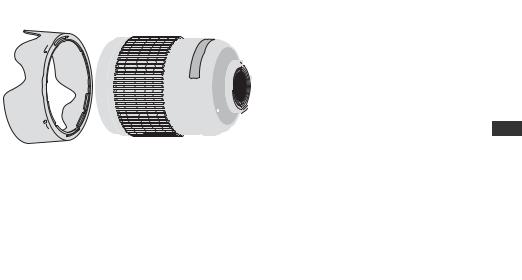
Nomenclature
( ) : reference page
|
1 Lens hood (P. 14) |
|
|
2 Lens hood attachment index (P. 14) |
|
|
3 Lens hood setting index (P. 14) |
|
|
4 Lens hood mounting index (P. 14) |
|
|
5 Zoom ring (P. 15) |
|
|
6 Focal length scale |
|
|
7 Focal length index |
|
|
8 Focus ring (P. 15) |
|
|
9 Mounting index (P. 14) |
|
|
0 CPU contacts (P. 17) |
En |
A |
a A-M mode switch (P. 15) |
|
b Vibration reduction ON/OFF |
|
|
|
switch (P. 16) |
|
B C D
13

Thank you for purchasing the AF-S DX NIKKOR 18-105mm f/3.5-5.6G ED VR lens. DX Nikkor lenses are specially designed for use with Nikon digital-SLR (Nikon DX format) cameras, such as the D300 and D90. When mounted on Nikon DX format cameras, the lens picture angle is equivalent to approximately 1.5×the focal length in 35mm format. Before using this lens, please read these instructions and refer to your camera’s User’s Manual.
Major features
•By enabling vibration reduction (VR), slower shutter speeds (approximately three stops*) can be used, thus increasing the range of usable shutter speeds and zoom positions, particularly when hand-holding the camera.
(*Based on results achieved under Nikon measurement conditions. The effects of vibration
En reduction may vary according to shooting conditions and use.)
•This lens employs a Silent Wave Motor to drive the focusing mechanism, making autofocusing smooth,
silent and almost instantaneous. The A-M mode switch ais provided for simple selection of autofocus (A) or manual focus (M) operation.
•More accurate exposure control is possible when this is mounted on a Nikon camera with 3D color matrix metering capability, because subject distance information is transferred from the lens to the camera.
•Superior optical performance and rendering characteristics are maximized with the use of one aspherical lens element and one extra-low dispersion (ED) glass element, which ensure correction of chromatic aberration. In addition, the rounded
aperture produces soft and pleasing blur characteristics in portions of pictures that are out-of- focus.
Mounting the lens
1 Turn the camera off.
2 Remove the rear lens cap (Fig. D).
3 Align the mounting index 9on the lens with the mounting mark on the camera, and rotate the lens counterclockwise until it clicks into place. Be sure that the lens is in the correct position when the mounting index 9is on the top of the lens.
4 Remove the front lens cap (Fig. C).
Removing the lens
Turn the camera off before removing the lens. Press and hold the lens-release button on the camera while turning the lens clockwise.
Using the Lens Hood HB-32 1
Attaching the hood
Align the lens hood attachment index ( , either of two indexes) 2on the hood with the lens hood mounting index 4on the lens, and turn the hood 1 counterclockwise (as viewed when holding the camera
, either of two indexes) 2on the hood with the lens hood mounting index 4on the lens, and turn the hood 1 counterclockwise (as viewed when holding the camera
14

with the lens facing away from you) until it clicks into place (Fig. B).
Be sure that the lens hood mounting index is aligned with the lens hood setting index (  ) 3.
) 3.
If the lens hood is not correctly attached, vignetting may occur.
To facilitate attachment or removal of the hood, hold it by the base (near the lens hood attachment index) rather than its outer edge.
Detaching the hood
Hold the lens hood by the base (near the lens hood attachment index) and turn clockwise, as viewed when holding the camera with the lens facing away from you, to detach.
Focusing, zooming, and depth of field
Before focusing, rotate the zoom ring 5to adjust the
focal length until the desired composition is framed.
If your camera has a depth-of- field preview (stop-down) button or lever, depth of field
can be previewed through
the camera viewfinder. For more information, refer to your camera's User's Manual.
•This lens is equipped with the Internal Focusing (IF) system. As this focusing system differs from non-IF
lenses, focal length at closer distances decreases slightly.
Focusing (Fig. A)
Autofocus mode
Set the camera focus mode to AF-A, AF-S or AF-C and set the A-M mode switch aon the lens to A. Press the shutter-release button halfway to focus and completely to shoot.
Manual focusing is possible even when the lens A-M mode switch is set to A.
Set the camera’s focus mode to AF-S, and press the shutter-release button halfway to initiate autofocus. Next,
while pressing the shutter-release button halfway, En manually rotate the lens focus ring 8to fine-tune focus.
Note: Do not attempt to rotate the focus ring while autofocus is operating. If autofocus stops operating, release and press the shutter-release button halfway again.
Manual focus mode
Set the A-M mode switch aon the lens to M. Rotate the focus ring 8manually to focus. Shooting is possible when camera focus mode is set to either AF or M.
Lens A-M |
Camera focus mode |
|
||
mode switch a |
AF-A/AF-C |
AF-S |
|
M |
A |
Autofocus |
Autofocus |
|
— |
(manual focus) |
|
|||
|
|
|
|
|
M |
Manual focus (focus assist is available) |
|||
15
For more information on camera focus modes, refer to your camera’s User’s Manual.
Getting good results with autofocus
Refer to “Notes on using wideor super wide-angle AF Nikkor lenses” (P. 19).
|
Vibration reduction mode (VR) |
||
|
By enabling vibration reduction (VR), slower shutter |
||
|
speeds (approximately three stops*) can be used. |
||
|
Panning is also supported. |
||
|
(*Based on results achieved under Nikon measurement |
||
|
conditions. The effects of vibration reduction may vary |
||
|
according to shooting conditions and use.) |
||
|
Using vibration reduction |
||
En |
|||
1 Set the vibration reduction ON/OFF switch bto |
|||
|
|||
|
|
ON. |
|
|
|
Note: Be sure to set the switch bso that the |
|
|
2 |
indicator is precisely aligned with ON. |
|
|
Camera shake is reduced when the shutter-release |
||
|
|
button is pressed halfway. Autofocus and manual |
|
|
|
focusing, as well as precise framing of the subject, |
|
|
|
are simplified because camera shake visible |
|
|
3 |
through the viewfinder is also reduced. |
|
|
To disable vibration reduction, set the vibration |
||
|
|
reduction ON/OFF switch bto OFF. |
|
|
Notes on using vibration reduction |
||
|
• |
After pressing the shutter-release button halfway, |
|
|
|
wait until the image in the viewfinder stabilizes |
|
before pressing the shutter-release button the rest of the way down.
•If the camera is panned in a wide arc, compensation for camera shake in the panning direction is not performed. For example, when panning the camera in a horizontal direction, vertical camera shake is reduced. This stabilizes the image whilst allowing the desired panning effect to be realized.
•Due to the characteristics of the vibration reduction mechanism, the image in the viewfinder may be blurred after the shutter is released. This is not a malfunction.
•Do not turn the camera off or remove the lens from the camera while vibration reduction is operating. Failure to observe this note could result in the lens sounding and feeling as if an internal component is loose or broken when it is shaken. This is not a malfunction. Turn the camera on again to correct this.
•With cameras such as D300 and D40-series models, featuring a built-in flash, vibration reduction does not function while the built-in flash is charging.
•When the camera is mounted on a tripod, set the vibration reduction ON/OFF switch bto OFF.
However, it is recommended that the switch be set to ON when using the camera on an unsecured tripod head or with monopod.
•With autofocus cameras such as D2-series and D300 models, featuring an AF-ON button, vibration reduction does not function when the AF-ON button is pressed.
Setting the aperture
Use the camera to adjust the aperture setting.
16
Variable maximum apertures
Zooming the lens changes the maximum aperture by up to 11/3 stop.
However, the camera will compensate for any change in aperture by adjusting the shutter speed so as to
maintain the correct exposure value.
The built-in flash and vignetting
Vignetting is the darkening of the corners around the image that occurs when the light emitted by the flash is obstructed by the lens hood 1, or lens barrel, depending on the focal length or shooting distance.
•To prevent vignetting, do not use the lens hood 1.
•The built-in flash cannot be used over distances of less than 0.6 m (2.0 ft.).
Digital-SLR cameras |
Supported focal length/ |
|
shooting distance |
||
D5000/D3000 |
• 18mm/2.5 m (8.2 ft.) or greater |
|
• 24mm/1 m (3.3 ft.) or greater |
||
|
||
D700/D300-series/ |
No vignetting occurs at any focal |
|
D200/D100/D80 |
length |
|
D90/D70-series |
• 18mm/1.5 m (4.9 ft.) or greater |
|
• 24mm or longer/no restrictions |
||
|
||
D50 |
• 18mm/1 m (3.3 ft.) or greater |
|
• 24mm or longer/no restrictions |
||
|
||
|
• 18mm/2.5 m (8.2 ft.) or greater |
|
D60/D40-series |
• 24mm/1 m (3.3 ft.) or greater |
|
|
• 35mm or longer/no restrictions |
The built-in flash on the D100 and D70 is compatible with focal lengths of 20mm or greater.
Vignetting occurs at a focal length of 18mm.
Lens care
•Be careful not to allow the CPU contacts 0to become dirty or damaged.
•Clean lens surfaces with a blower brush. To remove dirt and smudges, use a soft, clean cotton cloth or lens tissue moistened with ethanol (alcohol) or lens cleaner. Wipe in a circular motion from the center to the outer edge, taking care not to leave traces or touch other parts of the lens.
•Never use organic solvent such as thinner or benzene to clean the lens.
•NC filters are available to protect the front lens element. The lens hood 1also helps to protect the
front of the lens. |
En |
•When storing the lens in its flexible lens pouch, attach
both the front and rear lens caps. The lens can also be stored with the lens hood 1attached in the reverse position.
•When the lens is mounted on a camera, do not pick up or hold the camera and lens by the lens hood 1.
•When the lens will not be used for an extended period of time, store it in a cool, dry place to prevent mold and rust. Be sure to store the lens away from direct sunlight or chemicals such as camphor or naphthalene.
•Do not get water on the lens or drop it in water as this will cause it to rust and malfunction.
•Reinforced plastic is used for certain parts of the lens. To avoid damage, never leave the lens in an excessively hot place.
17

Standard accessories
•67mm Snap-on Front Lens Cap LC-67
•Rear Lens Cap LF-1
•Bayonet Hood HB-32
•Flexible Lens Pouch CL-1018
Optional accessory
67mm screw-on filters
Incompatible accessories
•Teleconverters (all models)
•Auto Ring BR-4 and all models of Auto Extension Ring PK, K Ring and Bellows focusing attachment.
•Attachment Ring SX-1
En Other accessories may not be suitable for use with this lens. For details, refer to the documentation provided with accessories.
Specifications
Type of lens |
G-type AF-S DX Zoom-NIKKOR lens |
|
with built-in CPU and Nikon bayonet |
|
mount (specially designed for use |
|
with Nikon digital-SLR—Nikon DX |
|
format—cameras) |
Focal length |
18mm–105mm |
Maximum |
f/3.5–5.6 |
aperture |
|
Lens |
15 elements in 11 groups (1 aspherical |
construction |
lens and 1 ED lens elements) |
Picture angle |
76º–15º20’ |
Focal length scale |
18, 24, 35, 50, 70, 105mm |
Distance |
Output to camera |
information |
|
Zoom control |
Manually via separate zoom ring |
Focusing |
Nikon Internal Focusing (IF) system, |
|
Autofocus using a Silent Wave Motor; |
|
manually via separate focus ring |
Vibration |
Lens-shift method using voice coil |
reduction |
motors (VCMs) |
Closest focus |
0.45 m (1.5 ft.) at all zoom settings |
distance |
|
No. of diaphragm |
7 pcs. (rounded) |
blades |
|
Diaphragm |
Fully automatic |
Aperture range |
f/3.5 to f/22 (at 18mm), f/5.6 to f/38 |
|
(at 105mm) |
Exposure |
Via full-aperture method |
measurement |
|
Attachment size |
67 mm (P = 0.75 mm) |
Dimensions |
Approximately 76 mm (dia.) ×89 mm |
|
(extension from the camera’s lens- |
|
mount flange) |
Weight |
Approximately 420 g (14.8 oz) |
Specifications and designs are subject to change without notice or obligation on the part of the manufacturer.
18
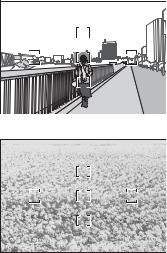
Notes on using wideor super wide-angle AF Nikkor lenses
In the following situations, autofocus may not perform as expected when shooting with wideor super wide-angle AF Nikkor lenses.
EA person standing in front of a distant background
F A field filled with flowers
1.When the main subject in the focus brackets is relatively small
When a person standing in front of a distant background is positioned within the focus brackets, as shown in Fig. E, the background may be in focus, while the subject is out of focus.
2.When the main subject is a finely
patterned subject or scene
When the subject is finely patterned or of low |
En |
contrast, such as a field filled with flowers, as shown |
|
in Fig. F, focus may be difficult to acquire using |
|
autofocus. |
|
Responses to these types of situations |
|
(1)Focus on a different subject located at the same distance from the camera, apply focus lock, recompose, and shoot.
(2)Set the camera’s focus mode to manual focus and
focus manually on the subject.
Refer to “Getting Good Results with Autofocus” in the camera’s User’s Manual.
19

Hinweise für sicheren Betrieb
 ACHTUNG
ACHTUNG
Keinesfalls zerlegen.
Beim Berühren der Innenteile von Kamera oder Objektiv droht Verletzungsgefahr. Überlassen Sie Reparaturen unbedingt ausschließlich qualifizierten Technikern. Kommt es durch einen heftigen Stoß (z.B. Fall auf den Boden) zu einem Bruch von Kamera oder Objektiv, so trennen Sie zunächst das Produkt vom Stromnetz bzw. entnehmen die Batterie(n) und geben es dann an eine autorisierte Nikon-Servicestelle zur Überprüfung ab.
Bei einer Störung sofort die Stromversorgung ausschalten.
Bei Entwicklung von Rauch oder ungewöhnlichem Geruch durch Kamera oder Objektiv entnehmen Sie sofort die
De Batterie(n); dabei vorsichtig vorgehen, denn es besteht Verbrennungsgefahr. Bei einem Weiterbetrieb unter diesen Umständen droht Verletzungsgefahr.
Nach dem Abtrennen von der Stromversorgung geben Sie das Gerät an eine autorisierte Nikon-Servicestelle zur Überprüfung ab.
Kamera oder Objektiv keinesfalls bei Vorhandensein von brennbarem Gas einsetzen.
Wird elektronisches Gerät bei brennbarem Gas betrieben, so droht u.U. Explosionsoder Brandgefahr.
Keinesfalls durch Objektiv oder Sucher in die Sonne blicken.
Beim Betrachten der Sonne oder anderer starker Lichtquellen durch Objektiv oder Sucher droht eine permanente Schädigung des Sehvermögens.
Dem Zugriff von Kindern entziehen.
Es ist unbedingt dafür zu sorgen, dass Kleinkinder keine Batterien oder andere Kleinteile in den Mund nehmen können.
Beim Umgang mit Kamera und Objektiv unbedingt die folgenden Vorsichtmaßnahmen beachten:
•Schützen Sie die Kamera und das Objektiv vor Feuchtigkeit. Andernfalls droht Brandoder Stromschlaggefahr.
•Handhaben oder berühren Sie die Kamera bzw. das Objektiv keinesfalls mit nassen Händen. Andernfalls droht Stromschlaggefahr.
•Bei Gegenlichtaufnahmen nicht das Objektiv gegen die Sonne richten oder das Sonnenlicht direkt durch das Objektiv eintreten lassen. Dies könnte eine Überhitzung der Kamera verursachen und ein Brand könnte die Folge sein.
•Vor einem längeren Nichtgebrauch des Objektivs bringen Sie den vorderen und hinteren Deckel an und bewahren das Objektiv geschützt vor direkter Sonnenlichteinwirkung auf. Andernfalls droht Brandgefahr wegen möglicher Fokussierung von Sonnenlicht durch das Objektiv auf brennbare Gegenstände.
20
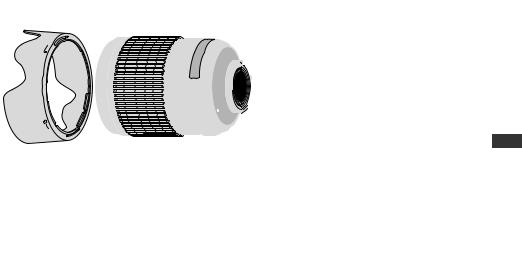
Bezeichnung der Bauteile
( ): Seite mit weiteren Erläuterungen
|
1 Gegenlichtblende (S. 22) |
|
2 Gegenlichtblende-Anbringindex (S. 22) |
|
3 Gegenlichtblende-Einstellindex (S. 22) |
|
4 Gegenlichtblende-Montageindex (S. 22) |
|
5 Zoom-Einstellring (S. 23) |
|
6 Brennweitenskala |
|
7 Markierung der Brennweitenskala |
|
8 Entfernungseinstellring (S. 23) |
|
9 Montage-Markierung (S. 22) |
|
0 CPU-Kontakte (S. 25) |
A |
a Fokus-Modusschalter (A-M) (S. 23) De |
b Bildstabilisator-Schalter |
|
|
ON/OFF (S. 24) |
B C D
21

Wir danken Ihnen für das Vertrauen, das Sie Nikon mit dem Kauf des AF-S DX NIKKOR 18-105mm 1:3,5-5,6G ED VR entgegenbringen. DX NIKKORObjektive sind speziell für den Gebrauch mit Nikon Digital-Spiegelreflexkameras (Nikon DX-Format) ausgelegt, wie etwa die D300 und die D90. Wird das Objektiv an Kameras im Nikon-DX-Format angebracht, so entspricht der Bildwinkel des Objektivs ca. dem 1,5-Fachen der Brennweite im Kleinbildformat. Machen Sie sich bitte vor dem Gebrauch dieses Objektivs mit dem Inhalt dieser Bedienungsanleitung und dem Benutzerhandbuch Ihrer Kamera vertraut.
Hauptmerkmale
•Bei eingeschaltetem Bildstabilisator (VR) können längere Belichtungszeiten (ca. drei Stufen*) verwendet werden. Auf diese Weise werden der Bereich der anwendbaren Belichtungszeiten und die Zoompositionen erweitert, besonders bei Freihandhaufnahmen.
(*Basierend auf Ergebnissen, die unter NikonMessbedingungen erzielt wurden. Die Wirkung des
Bildstabilisators kann je nach Aufnahmebedingungen und Einsatz variieren.)
De • Der Fokussiermechanismus des Objektivs wird von einem Silent Wave Motor angetrieben, so dass die Scharfeinstellung per Autofokus stufenlos, geräuscharm und praktisch verzögerungsfrei erfolgt. Mit dem Fokus-Modusschalter (A-M) alässt sich mühelos zwischen Autofokus (A) und manueller Scharfeinstellung (M) wechseln.
•Eine besonders präziseBelichtungssteuerung resultiert, wenn das Objektiv auf eine Nikon-Kamera mit 3D-Color-Matrixmessung montiert wird, da die Motiventfernungsdaten vom Objektiv zur Kamera übertragen werden.
•Außergewöhnliche optische Performanz und hohe Wiedergabequalität durch ein asphärisches Linsenelement und ein Glaselement mit extrem niedriger Dispersion (ED), wodurch eine Korrektur von chromatischen Aberrationen gewährleistet
wird. Außerdem generiert die gerundete Blende weiche und ansprechende Unschärfeeffekte in Bildteilen, die unscharf sind.
Anbringen des Objektivs
1 Schalten Sie die Stromversorgung der Kamera aus. 2 Nehmen Sie den hinteren Objektivdeckel ab (Abb. D). 3 Fluchten Sie die Montagemarkierungen 9an Objektiv und
Kamera, und drehen Sie das Objektiv gegen den Uhrzeigersinn, bis es hörbar einrastet. Stellen Sie sicher, dass sich das Objektiv in der korrekten Position befindet, wenn sich die Montagemarkierung 9oben auf dem Objektiv befindet.
4 Nehmen Sie den vorderen Objektivdeckel ab (Abb. C).
Abnehmen des Objektivs
Vor dem Abnehmen des Objektivs muss die Kamera unbedingt ausgeschaltet werden. Halten Sie die Objektiv-Freigabetaste gedrückt und drehen Sie das Objektiv im Uhrzeigersinn.
Verwendung der Gegenlichtblende HB-32 1
Anbringen der Gegenlichtblende
Richten Sie die Gegenlichtblende-Montagemarkierung ( , eine der beiden Markierungen) 2an der Gegenlichtblende und die GegenlichtblendeMontagemarkierung 4am Objektiv aneinander aus und drehen Sie die Gegenlichtblende 1gegenden Uhrzeigersinn(vonderRückseite derKamera aus betrachtet), bis sie mit einem Klicken einrastet (Abb. B).
, eine der beiden Markierungen) 2an der Gegenlichtblende und die GegenlichtblendeMontagemarkierung 4am Objektiv aneinander aus und drehen Sie die Gegenlichtblende 1gegenden Uhrzeigersinn(vonderRückseite derKamera aus betrachtet), bis sie mit einem Klicken einrastet (Abb. B).
22

Achten Sie darauf, die GegenlichtblendeMontagemarkierung und die GegenlichtblendeEinstellmarkierung (  ) 3aneinander auszurichten. Wenn die Gegenlichtblende nicht richtig angebracht ist, wirft sie u.U. einen Schatten ins Motiv.
) 3aneinander auszurichten. Wenn die Gegenlichtblende nicht richtig angebracht ist, wirft sie u.U. einen Schatten ins Motiv.
Um das Anbringen bzw. Abnehmen der Gegenlichtblende zu erleichtern, diese an der Basis (in der Nähe der Blendenbefestigungsmarkierung) und nicht an den äußeren Kanten fassen.
Abnehmen der Gegenlichtblende
Die Gegenlichtblende zum Lösen an der Basis fassen (in der Nähe der Blendenbefestigungsmarkierung) und von der Rückseite der Kamera aus gesehen im Uhrzeigersinn drehen.
Scharfeinstellung, Zoomen und Schärfentiefe
Vor der Scharfeinstellung durch Drehendes Zoom-Einstellrings5
die Brennweite so weit verstellen, bis der gewünschte Bildausschnitt
im Sucher zu sehen ist. Wenn die Kamera mit einer Abblendtaste oder einem Abblendhebel für die Tiefenschärfevorschauausgestattetist,
lässt sich die Tiefenschärfe beim Blick durch den Kamerasucher beurteilen. Weitere Informationen finden Sie im Benutzerhandbuch Ihrer Kamera.
•Dieses Objektiv ist mit dem System Internal Focusing (interne Scharfeinstellung) (IF) ausgestattet. Da sich dieses Scharfeinstellungssystem von nicht-IF Objektiven unterscheidet, nimmt die Brennweite bei näheren Entfernungen leicht ab.
Scharfeinstellung (Abb. A)
Autofokus-Modus
Stellen Sie den Kamera-Fokusmodus auf AF-A, AF-S oder AF-C ein und den FokusModusschalter (A-M) aam Objektiv auf A. Tippen Sie den Auslöser an, um zu fokussieren und drücken Sie dann zur Aufnahme den Auslöser ganz.
Manuelles Fokussieren ist möglich, auch wenn der Modusschalter des Objektivs A-M auf A gesetzt ist.
Stellen sie den Kamera-Fokusmodus auf AF-S und tippen Sie den Auslöser an, um den Autofokus zu starten. Drehen Sie dann während dem Antippen des Auslösers den EntfernungsEinstellring manuell 8, um den Fokus abzustimmen.
Hinweis: Versuchen Sie nicht während des Autofokus den Entfernungs-Einstellring zu drehen. Wenn der Autofokus De stoppt, den Auslöser freigeben und erneut antippen.
Manuelle Scharfeinstellung
Stellen Sie den Fokus-Modusschalter (A-M) aam Objektiv auf M. Drehen Sie den Einstellring 8zum Fokussieren mit der Hand. Aufnahmen sind möglich, wenn der Kamera-Fokusmodus auf AF oder M eingestellt ist.
A-M-Umschalter |
Kamera-Fokusmodus |
|
||
am Objektiv a |
AF-A/AF-C |
AF-S |
|
M |
|
|
|
|
|
A |
Autofokus |
Autofokus(manuelle |
|
— |
|
|
scharfeinstellung) |
|
|
M |
Manuelle Scharfeinstellung |
|||
(fokussierhilfe vorhanden) |
|
|||
|
|
|||
|
|
|
|
|
23

Weitere Informationen zum Kamera-Fokusmodus finden Sie im Benutzerhandbuch Ihrer Kamera.
Gute Ergebnisse mit dem Autofokus
Schlagen Sie bitte unter »Hinweise zum Gebrauch von AF-NIKKOR- Weitwinkelund -Superweitwinkelobjektiven« (S. 27) nach.
Bildstabilisator (VR)
Bei eingeschaltetem Bildstabilisator (VR) können längere Belichtungszeiten (ca. drei Stufen*) verwendet werden. Auch Schwenks sind möglich.
(*Basierend auf Ergebnissen, die unter Nikon-Messbedingungen erzielt wurden. Die Wirkung des Bildstabilisators kann je nach Aufnahmebedingungen und Einsatz variieren.)
Verwenden des Bildstabilisators
De 1 Stellen Sie den Bildstabilisator-Schalter ON/OFF bauf ON. Hinweis: Stellen Sie den Schalter bso ein, dass die Markierung genau an ON ausgerichtet ist.
2 Beim Antippen des Auslösers werden Vibrationen der Kamera nun reduziert. Auch die im Sucher sichtbaren Vibrationen der Kamera werden reduziert, was die automatische oder manuelle Scharfeinstellung sowie die exakte Auswahl des Bildausschnitts erleichtert.
3Um den Bildstabilisator auszuschalten, stellen Sie den Bildstabilisator-Schalter ON/OFF bauf OFF.
Hinweise zum Bildstabilisator
•Tippen Sie den Auslöser an, warten Sie, bis sich das Bild im Sucher stabilisiert hat, und drücken Sie erst dann den Auslöser ganz nach unten.
•Wenn Sie die Kamera bei einem Schwenk in einem weiten Bogen bewegen, so werden Kameravibrationen in Richtung dieser Bewegung
nicht ausgeglichen. Wenn Sie z.B. die Kamera horizontal schwenken, werden Kameravibrationen in vertikaler Richtung reduziert. Dies stabilisiert das Bild und dabei wird der gewünschte Schwenkeffekt erzielt.
•Aufgrund der Eigenschaften des Bildstabilisierungsmechanismus erscheint das Bild im Sucher nach dem Auslösen unter Umständen verschwommen. Dies ist jedoch keine Fehlfunktion.
•Schalten Sie die Kamera nicht aus und nehmen Sie auch nicht das Objektiv von der Kamera ab, solange der Bildstabilisator arbeitet. Andernfalls kann beim Schütteln des Objektivs ein Geräusch zu hören sein, als seien innere Bauteile lose oder gebrochen. Dies ist jedoch keine Fehlfunktion. Schalten Sie einfach die Kamera wieder ein, um das Problem zu beheben.
•Bei Kameras mit eingebautem Blitz, beispielsweise aus den D300 und D40, funktioniert der Bildstabilisator nicht, solange der eingebaute Blitz geladen wird.
•Wenn die Kamera auf einem Stativ montiert ist, stellen Sie den Bildstabilisator-Schalter ON/OFF bauf OFF. Wenn Sie jedoch die Kamera auf einen unverriegelten
Stativkopf oder ein Einbeinstativ (Monopod) befestigen, sollte der Schalter auf ON gestellt werden.
•Bei Autofokus-Kameras, wie beispielsweise den Modellen der D2-und D300-Serie, die mit einer AF-ON-Taste ausgestattet sind, funktioniert der Bildstabilisator nicht, wenn die AF-ON-Taste gedrückt wird.
Blendeneinstellung
Stellen Sie die Blende an der Kamera ein.
Variable maximale Blenden
Durch Zoomen des Objektivs wird die maximale Blende um bis zu 11/3 Stufen geändert.
24
Die Kamera kompensiert jedoch jede Blendenänderung durch Anpassen der Belichtungszeit, damit der korrekte Belichtungswert beibehalten wird.
Eingebauter Blitz und Vignettierung
Unter Vignettierung versteht man die Abdunkelung der Bildecken, wenn das Blitzlicht von der Gegenlichtblende 1oder, je nach Brennweite oder Aufnahmedistanz, vom Objektivtubus verdeckt wird.
•Verwenden Sie keine Gegenlichtblende 1, da diese einen Schatten ins Motiv werfen könnte.
•Der eingebaute Blitz kann nicht für Entfernungen von unter 0,6 m eingesetzt werden.
Digitale |
Einstellbare Brennweite/ |
|
Spiegelreflexkameras |
Aufnahmedistanz |
|
|
|
|
D5000/D3000 |
• 18mm/2,5 m oder weiter |
|
• 24mm/1 m oder weiter |
||
|
||
|
|
|
D700/D300-Serie/ |
Keine Vignettierung, unabhängig |
|
D200/D100/D80 |
von der Brennweite |
|
|
• 18mm/1,5 m oder weiter |
|
D90/D70-Serie |
• 24mm oder länger/keine |
|
|
Einschränkungen |
|
|
• 18mm/1 m oder weiter |
|
D50 |
• 24mm oder länger/keine |
|
|
Einschränkungen |
|
|
• 18mm/2,5 m oder weiter |
|
D60/D40-Serie |
• 24mm/1 m oder weiter |
|
• 35mm oder länger/keine |
||
|
||
|
Einschränkungen |
|
|
|
Der eingebaute Blitz bei Kameras der Serie D100 und D70 eignet sich für Brennweiten von 20mm oder größer. Bei einer Brennweite von 18mm kommt es zur Vignettierung.
Pflege des Objektivs
•Halten Sie die CPU-Kontakte 0stets sauber und schützen Sie sie vor Beschädigung.
•Säubern Sie Glasflächen mit einem Blasepinsel. Staub und Flecken entfernen Sie mit einem sauberen, weichen Baumwolltuch oder Optik-Reinigungspapier, das Sie mit Ethanol (Alkohol) oder OptikReinigungsflüssigkeit anfeuchten. Wischen Sie in kreisförmigen Bewegungen von der Mitte nach außen, ohne dass Wischspuren zurückbleiben oder Sie andere Teile des Objektivs berühren.
•Verwenden Sie niemals organische Lösungsmittel wie Verdünner oder Benzin zum Reinigen des Objektivs.
• Zum Schutz der Vorderlinse sind Filter des Typs NC erhältlich. Die |
|
|
De |
||
Gegenlichtblende 1wirkt als zusätzlicher Frontlinsenschutz. |
||
|
•Beim Verstauen des Objektivs in seinem flexiblen Etui müssen vorderer und hinterer Deckel aufgesetzt sein. Das Objektiv
lässt sich auch dann verstauen, wenn die Gegenlichtblende 1in der umgekehrten Position angebracht ist.
•Halten Sie die Kamera und das Objektiv nicht an der Gegenlichtblende 1, wenn das Objektiv an der Kamera angebracht ist.
•Bei längerer Nichtbenutzung sollte das Objektiv an einem kühlen, trockenen Ort aufbewahrt werden, um Schimmelbildung und Rost zu vermeiden. Halten Sie das Objektiv von direkter Sonneneinstrahlung oder Chemikalien wie Kampfer oder Naphthalin fern.
•Halten Sie das Objektiv von Wasser fern, das zur Korrosion und zu Betriebsstörungen führen kann.
•Einige Teile des Objektivs bestehen aus verstärktem Kunststoff. Lassen Sie das Objektiv deshalb nie an übermäßig heißen Orten liegen!
25
Serienmäßiges Zubehör
•Vorderer Objektivdeckel mit Schnappverschluss (67mm) LC-67
•Hinterer Objektivdeckel LF-1
•Bajonett-Gegenlichtblende HB-32
•Objektivbeutel CL-1018
Sonderzubehör
67mm-Schraubfilter
Nicht geeignetes Zubehör
• Telekonverter (alle Modelle)
• Auto-Ring BR-4 und alle Modelle von AutoZwischenring PK, K-Ring und Balgenvorsatz.
|
• Anschlussring SX-1 |
|
De |
||
Auch anderes Zubehör ist möglicherweise nicht für |
||
|
||
|
dieses Objektiv geeignet. Einzelheiten entnehmen Sie |
|
|
bitte der Dokumentation zu dem jeweiligen Zubehör. |
Technische Daten
Objektivtyp |
AF-S DX Zoom-NIKKOR-Objektiv Typ G mit |
|
integrierter CPU und Nikon-Bajonettfassung |
|
(speziell ausgelegt für den Gebrauch mit Nikon |
|
Digital-SLR-Kameras - NIKON DX-Format) |
Brennweite |
18–105mm |
Maximale |
1:3,5–5,6 |
Blendenöffnung |
|
Objektivaufbau |
15Elementein11Linsengruppen(1asphärisches |
|
Linsenelement und 1 ED-Linsenelemente) |
Bildwinkel |
76º–15º20’ |
Brennweitenskala |
18, 24, 35, 50, 70, 105mm |
Entfernungsdaten Übertragung zu Kamera |
|
Zoomen |
Manuell über separaten Zoomring |
ScharfeinstellungNikon Internal Focusing (interne |
|
|
Scharfeinstellung) (IF), Autofokus mit |
|
Silent Wave Motor, manuell über |
|
separaten Entfernungs-Einstellring |
Bildstabilisator |
Objektivverschiebung mit VCMs (Voice |
|
Coil Motors - Schwingspulenmotoren) |
Kürzeste |
0,45 m bei allen Zoomeinstellungen |
Aufnahmedistanz |
|
Blende |
Irisblende mit 7 gerundeten Lamellen |
Blendenart |
Vollautomatisch |
Blendenbereich |
f/3,5 bis f/22 (bei 18mm), f/5,6 bis |
|
f/38 (bei 105mm) |
Belichtungsmessung Offenblendenmessung
Befestigungsgröße 67 mm (P = 0,75 mm)
Abmessungen |
ca. 76 mm (Durchm.) × 89 mm (zum |
|
Objektivmontageflansch der Kamera) |
Gewicht |
ca. 420 g |
Änderungen von technischen Daten und Design durch den Hersteller ohne Ankündigung und ohne Verpflichtungen irgendeiner Art vorbehalten.
26
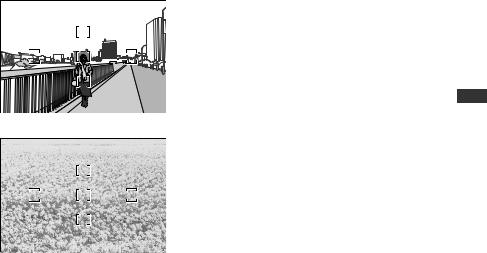
Hinweise zum Gebrauch von AF-NIKKOR-Weitwinkel- und -Superweitwinkelobjektiven
In den folgenden Fällen funktioniert der Autofokus bei der Aufnahme von Bildern mit AF-NIKKOR-Weitwinkel- und - Superweitwinkelobjektiven u.U.nicht erwartungsgemäß.
EEine Person vor einem weit entfernten Hintergrund
F Eine Blumenwiese |
1.Hauptmotiv in den Fokusklammern relativ klein
Wenn das Hauptmotiv nur einen geringen Teil des aktiven Fokusmessfelds abdeckt, wie an den Fokusmessfeld-Markierungen in Abb. E zu sehen, stellt die Kamera unter Umständen auf den Hintergrund, nicht jedoch das Hauptmotiv scharf.
2.Kleinteilig strukturierte Fläche oder Szene als Hauptmotiv
Bei Motiven mit kleinteiliger Strukturierung oder geringem Kontrast, zum Beispiel einer Blumenwiese De wie in Abb. F zu sehen, ist eine Scharfeinstellung per Autofokus u.U.schwierig.
Lösungsmöglichkeiten für solche Fälle
(1)Fokussieren Sie zunächst auf ein anderes Motiv im selben Abstand von der Kamera, wählen Sie dann bei Fokussperre erneut den Bildausschnitt und machen Sie so die Aufnahme.
(2)Stellen Sie die Fokussteuerung auf manuelles Fokussieren ein und stellen Sie von Hand auf das
Motiv scharf.
Näheres zu diesem Thema finden Sie außerdem unter »Gute Ergebnisse mit dem Autofokus« in der
Benutzerhandbuch zur Kamera.
27

Remarques concernant une utilisation en toute sécurité
 ATTENTION
ATTENTION
Ne pas démonter
Le fait de toucher aux pièces internes de l'appareil ou de l'objectif pourrait entraîner des blessures. Les réparations doivent être effectuées par des techniciens qualifiés. Si l'appareil ou l'objectif est cassé suite à une chute ou un autre accident, apportez le produit dans un centre de service agréé Nikon pour le faire vérifier après avoir débranché le produit et retiré les piles.
En cas de dysfonctionnement, éteignez l'appareil immédiatement
Si vous remarquez de la fumée ou une odeur inhabituelle se dégageant de l'appareil photo ou de l'objectif, retirez immédiatement les piles, en prenant soin de ne pas vous brûler.
Fr Continuer d'utiliser son matériel peut entraîner des blessures. Après avoir retiré ou débranché la source d'alimentation, confiez le produit à un centre de service agréé Nikon pour le faire vérifier.
N'utilisez pas l'appareil photo ou l'objectif en présence de gaz inflammable
L'utilisation de matériel électronique en présence de gaz inflammable risquerait de provoquer une explosion ou un incendie.
Ne regardez pas le soleil dans l'objectif ou le viseur
Regarder le soleil ou toute autre source lumineuse violente dans l'objectif ou le viseur peut provoquer de graves lésions oculaires irréversibles.
Tenir hors de portée des enfants
Faites extrêmement attention à ce que les enfants ne mettent pas à la bouche les piles ou d'autres petites pièces.
Observez les précautions suivantes lorsque vous manipulez l'appareil et l'objectif
•Maintenez l'appareil photo et l'objectif au sec. Le nonrespect de cette précaution peut provoquer un incendie ou une électrocution.
•Ne manipulez pas et ne touchez pas l'appareil photo ou l'objectif avec les mains humides. Le non-respect de cette précaution peut provoquer une électrocution.
•Lors d'une prise de vue à contre-jour, ne dirigez pas l'objectif vers le soleil et évitez que les rayons du soleil pénètrent dans l'objectif ; l'appareil photo pourrait chauffer à l'excès, ce qui risquerait de provoquer un incendie.
•Lorsque vous n'utilisez pas l'objectif pendant une période prolongée, fixez les bouchons avant et arrière, et rangez l'objectif à l'abri de la lumière directe du soleil. Le non-respect de cette précaution peut provoquer un incendie, car l'objectif peut concentrer la lumière du soleil sur un objet inflammable.
28
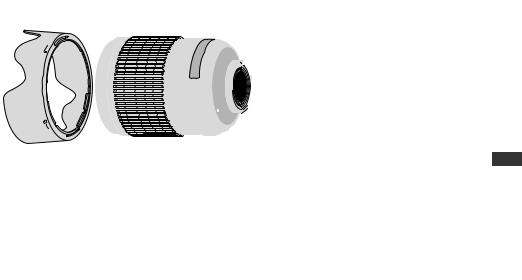
Nomenclature
( ) : page de référence
|
1 Parasoleil (P. 30) |
|
|
2 Repère de fixation du parasoleil (P. 30) |
|
|
3 Repère de réglage du parasoleil (P. 30) |
|
|
4 Repère de montage du parasoleil (P. 30) |
|
|
5 Bague de zoom (P. 31) |
|
|
6 Echelle des focales |
|
|
7 Repère des focales |
|
|
8 Bague de mise au point (P. 31) |
|
|
9 Repère de montage (P. 30) |
|
|
0 Contacts CPU (P. 33) |
|
A |
a Commutateur de mode A-M (P. 31) |
|
b Commutateur ON/OFF de |
Fr |
|
|
réduction de vibration (P. 32) |
|
|
|
B C D
29
Nous vous remercions d'avoir choisi l'objectif AF-S DX NIKKOR 18-105mm f/3,5-5,6G ED VR. Les objectifs DX Nikkor sont spécialement conçus pour les reflex numériques Nikon (format Nikon), notamment ceux des séries D300 et D90. Une fois monté sur des appareils photo au format Nikon DX, l'angle de champ de l'objectif est environ égal à 1,5× la focale en format 24 × 36 mm. Avant d'utiliser cet objectif, veuillez lire ces instructions et vous reporter au Manuel d'utilisation de votre appareil photo.
Principales caractéristiques
•Lorsque vous activez la réduction de vibration (VR), il est possible de prendre des photos à des vitesses d'obturation d'environ trois valeurs inférieures à celles normalement utilisées* ; vous augmentez ainsi la plage des vitesses d'obturation et des positions de zoom disponibles, notamment lorsque vous tenez l'appareil photo à la main. (*Selon les résultats obtenus dans les conditions de mesure Nikon. Les effets de la réduction de vibration varient selon les conditions de prise de vue et d'utilisation.)
•Cet objectif utilise un moteur silencieux SWM pour entraîner
|
le mécanisme de mise au point, permettant un autofocus |
|
Fr |
||
régulier, silencieux et presque instantané. Le commutateur |
||
|
||
|
de mode A-M asert à sélectionner facilement les modes |
|
|
autofocus (A) et mise au point manuelle (M). |
•Un contrôle de l'exposition plus précis est possible lors de l'installation de cet objectif sur un appareil photo Nikon muni de la fonction de mesure matricielle couleur 3D, car les informations de distance au sujet sont transférées de l'objectif à l'appareil photo.
•L'utilisation d'une lentille asphérique et d'une lentille en verre à dispersion extra-faible (ED), qui permet la correction de l'aberration chromatique, offre de remarquables performances optiques pour un rendu exceptionnel. En outre, l'ouverture arrondie permet
de créer des effets de flou intéressants et de rendre les zones de l'image non mises au point plus naturelles.
Fixation de l'objectif
1 Éteignez l'appareil photo.
2 Ôtez le bouchon d'objectif arrière (Fig. D).
3 Alignez le repère de montage 9de l'objectif avec le repère de montage de l'appareil photo, puis faites pivoter l'objectif dans le sens inverse des aiguilles d'une montre jusqu'à ce qu'il se mette en place. Assurez-vous que l'objectif est correctement positionné lorsque le repère de montage 9se trouve au-dessus de l'objectif.
4 Ôtez le bouchon d'objectif avant (Fig. C).
Retrait de l'objectif
Mettez l'appareil photo hors tension avant de retirer l'objectif. Maintenez enfoncée la commande de déverrouillage de l'objectif située sur l'appareil photo tout en faisant pivoter l'objectif dans le sens des aiguilles d'une montre.
Utilisation du parasoleil HB-32 1
Fixation du parasoleil
Alignez le repère de fixation du parasoleil ( , l'un des deux repères) 2sur le parasoleil avec le repère de montage du parasoleil 4sur l'objectif et tournez le parasoleil 1dans le sens inverse des aiguilles d'une montre (vu à partir de l'arrière de l'appareil photo) jusqu'au déclic de mise en place (Fig. B).
, l'un des deux repères) 2sur le parasoleil avec le repère de montage du parasoleil 4sur l'objectif et tournez le parasoleil 1dans le sens inverse des aiguilles d'une montre (vu à partir de l'arrière de l'appareil photo) jusqu'au déclic de mise en place (Fig. B).
30
